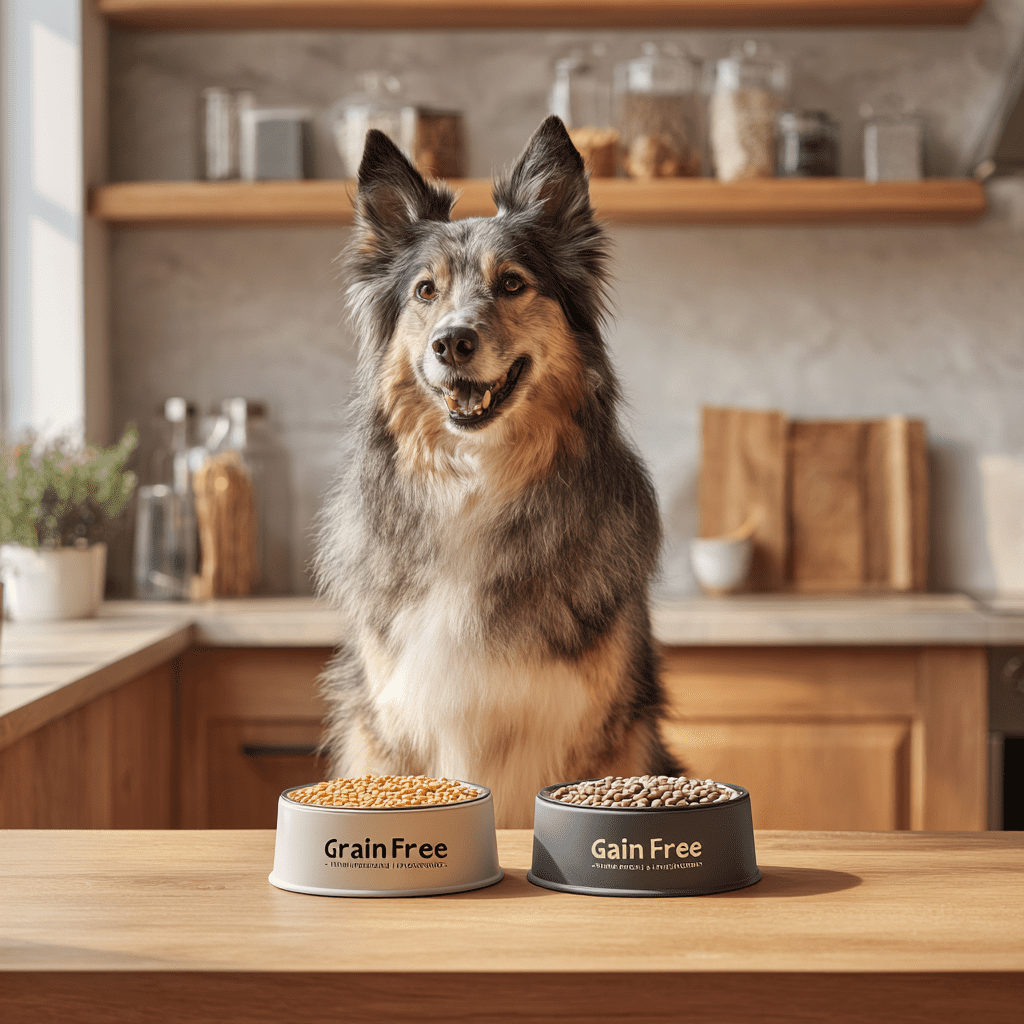1. Introduction: The Grain‑Free Craze 🚀
In recent years, grain‑free dog foods—using ingredients like peas, lentils, chickpeas, and potatoes—became wildly popular. Promoted as healthier and more natural than grain‑inclusive diets, they promised benefits like allergy relief, better digestion, and improved energy. However, since 2018 the FDA has investigated a possible connection between certain grain‑free diets and a serious heart condition called dilated cardiomyopathy (DCM). What’s the science, and what should you know before choosing grain‑free? Keep reading.
2. What Is Grain‑Free Dog Food?
Grain‑free dog food replaces traditional grains like wheat, corn, barley, and rice with alternative carbohydrates—often pulses (peas, lentils), potatoes, or tapioca. While these ingredients offer fiber and protein variety, they may interfere with nutrient absorption or cause imbalances in certain amino acids such as taurine or methionine
3. FDA & DCM: What’s the Concern?
In July 2018, the FDA launched an investigation after receiving hundreds of DCM cases in dogs eating grain‑free or “BEG” diets (boutique, exotic ingredient, grain‑free) Although DCM is typically genetic and rare, these cases occurred in breeds not normally predisposed, and over 90% of reported diets were grain‑free, especially those high in peas and lentils
4. Recent Research Findings
- A 2022 university study found that a pure pea-based grain‑free diet induced early DCM‑like changes within just 28 days in healthy dogs, affecting nutrient digestibility and heart function
- Other trials with pulse-based diets showed fewer changes, suggesting ingredient specifics (like pea vs lentil) matter greatly. Plasma taurine remained unchanged, but methionine and other amino acids dropped on certain formulations
Still, not all grain‑free foods cause issues—some short-term studies found no changes in taurine or heart health, stressing the role of formulation quality and ingredient sourcing
5. Key Contradictions & Conflicting Opinions
While the FDA has not confirmed causation, some veterinary experts argue the connection remains speculative and likely influenced by confounding factors and selective reporting . A review of nearly 150 studies concluded there is no definitive causal link between DCM and grain‑free diets, though quality control is essential
In short: grain‑free isn’t inherently bad, but problematic when poorly formulated, especially with high pulse content.
6. Pros and Cons of Grain‑Free Diets

✅ Potential Benefits:
- May help dogs with grain allergies or sensitivities
- Offers alternative protein/fiber sources
- Some high-quality brands offer nutritionally complete grain‑free options
❌ Potential Risks:
- Possible association with diet‑related DCM in some formulations
- Ingredient variability—pulses may reduce digestibility of key amino acids like methionine and taurine
- Not regulated terms—“holistic,” “natural,” and “grain‑free” can be misleading
7. So Should You Feed Grain‑Free?
Here’s a helpful decision guide:
| Scenario | What to Choose |
|---|---|
| No health issues, balanced diet | Grain‑inclusive foods by reputable brands |
| Known grain allergy or intolerance | Doctor‑recommended grain‑free diet with vet oversight |
| Puppies, seniors, sensitive breeds | Grain‑inclusive is safer unless directed otherwise |
Always consult your veterinarian, check for an AAFCO nutrient adequacy statement, and read ingredient lists carefully—avoid dog foods where peas, lentils, or potatoes are top ingredients unless formula has been tested and balanced
8. What to Watch For: Signs of DCM or Nutritional Imbalance
Be alert for symptoms like:
- Coughing or difficulty breathing
- Reduced stamina or early fatigue
- Sudden weight change or exercise intolerance
- Poor coat condition or skin issues
Routine veterinary diagnostics (bloodwork, heartscan, taurine levels) are the best way to monitor potential effects.
9. How to Safely Introduce or Transition Diets
- Switch gradually over 7–10 days.
- Monitor stool consistency, energy levels, and behavior.
- If signs of illness appear, revert to grain-inclusive and consult vet.
- Avoid sudden dietary swaps or unbalanced homemade grain-free recipes.
10. Final Verdict: Evidence vs Marketing
Grain‑free diets are not inherently harmful—but neither are they inherently beneficial. The controversy stems from historical marketing, unmet nutritional needs, and certain ingredients—not the absence of grains itself. Research continues, but the current consensus is that well-balanced, vet-approved grain-inclusive diets remain the safe default. Grain‑free may be an option for select pets, but caution and expert guidance are essential.
🏁 Final Thoughts
Your pet’s health depends less on catchy labels and more on balanced, complete nutrition—regulated by AAFCO standards, backed by reputable sources, and guided by your veterinarian. If you’re drawn to grain‑free because of allergies or preferences, research carefully, discuss with your vet, and always read labels. And remember: early detection, regular checkups, and quality control are key to preventing the rare but serious risks associated with poorly formulated diets.
